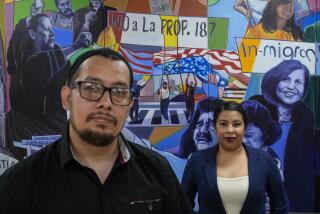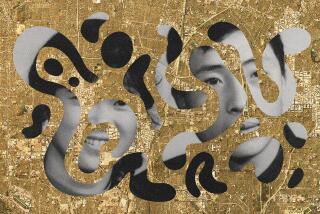PHILIPPINES : Amerasians Are Left Behind in U.S. Pullout
OLONGAPO, Philippines â Across the fetid canal that separates the U.S. Navy base at Subic Bay from this famed liberty town, a broken one-room shanty with no electricity and eight occupants is a stark vision of Americaâs mixed legacy in the Philippines.
Roxanne and Melanie Hill, both former bar girls, are Amerasians, named for their American grandfather, a U.S. serviceman. The two sisters have different fathers, both U.S. servicemen. Roxanne has three children, each by different American servicemen. Melanie has three more children, two by American fathers, one by a Filipino.
âNo one sends us money,â Roxanne, 32, said with a shrug, holding her youngest daughter, 3-year-old Jaylayne. âThey have forgotten us.â
Critics say America is forgetting thousands of Amerasians here as the U.S. military prepares to turn over its last Philippine base, the Cubi Point Naval Station, on Tuesday and finally withdraw from the impoverished island country it first seized from Spain in 1898 and then turned into Americaâs only colony.
Under legislation passed in 1982, the U.S. Congress gave children of American servicemen in South Korea, Thailand, Vietnam, Laos and Cambodia the right to immigrate under sponsorship from an American. No such law applies, however, to what an Irish priest here, Father Shay Cullen, has called the âthrow-away children of the U.S. Seventh Fleetâ in the Philippines.
âWe feel this needs to be addressed by legislation,â said William S. McCabe II, head of the Pearl S. Buck Foundation in Manila, which helps educate 3,500 Amerasian children in the Philippines and, when possible, to unite them with their fathers. âAt least give them an option to go to the States.â
His group has helped about 300 Amerasians move to the United States and obtain citizenship in the last decade. Illegitimate birth abroad, except to an American mother, does not confer U.S. citizenship. Instead, the American father must legitimize his children under the law of the state where he resides. Those cases are rare.
No one knows how many Amerasians are here. An early account cites 65 children left behind when the U.S. Quartermaster Corps troopship Logan left in 1914. Estimates since have grown steadily, and the total is clearly high. At the height of the Vietnam War, for example, nearly 1 million U.S. servicemen came through the Philippines, a major staging point and recreation area.
âI came here 24 years ago, and we used a figure of 50,000 since the Spanish-American War,â McCabe said. âBut itâs an impossible figure. I donât have the foggiest idea what it is.â
And clearly not all Amerasians here are poor or abandoned. Many have prospered and melted into society. Few complain of racial discrimination in this exceedingly tolerant country.
Eduardo Cojuangco Jr., for example, who ran for president earlier this year and is considered one of the countryâs wealthiest men, had an American mother. Richard Gordon, mayor of Olongapo, is the grandson of a U.S. serviceman and is married to an Amerasian recently elected to Congress.
But thousands of other Amerasians live as most Filipinos do--in appalling poverty. Their plight is only worsening as bars and businesses close with the departure of the Americans. The families have little but a worn photo and a fading memory of meeting a young American in the bars and brothels that once thrived outside Subic Bay and Clark Air Base, former home of the 13th Air Force.
âBefore, when we are together, we are very happy,â said Delta Patagnan, 37, a former Olongapo bar girl who met a Marine âfrom Ohio, Columbus,â five years ago and had a brown-haired son, Valpatrick. âHe came and saw the baby when he is born and says he will give me money. But he gives me nothing. We have no communication.â
The stories are sadly similar in the slums here. Black children, white children and children of every complexion in between play barefoot in dusty alleys near the sewage-filled canal that fronts the Subic base like a moat.
âI wrote to him on the boat,â said Clarisse Rios, 29, another former bar girl and mother of 5-year-old Kate Ann, a pale-skinned girl with big brown eyes and red streaks in her hair. The father was a 20-year-old sailor who left in 1986. âBut he doesnât respond. Heâs afraid of responsibility.â
âHeâs in the U.S. Air Force. His name is James,â recalled Elana Lasala, 39, mother of 5-year-old Katherine. They met near Clark, dated for two weeks, and then he left. âI donât try to write anymore,â she said, as her black-skinned daughter with kinky hair and a toothy grin played nearby. âHeâs married and has three kids. So I donât like to bother him.â
More to Read
Sign up for Essential California
The most important California stories and recommendations in your inbox every morning.
You may occasionally receive promotional content from the Los Angeles Times.











